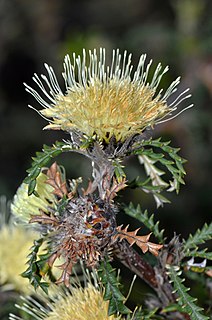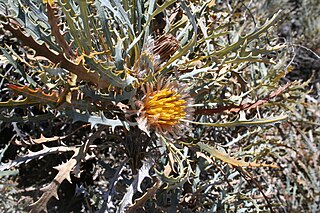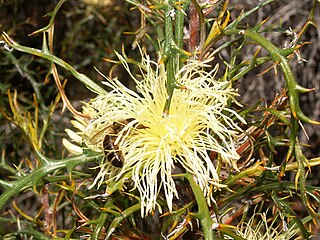
Banksia violacea, commonly known as violet banksia, is a species of shrub or tree in the plant genus Banksia. It generally grows as a small shrub to 1.5 m (5 ft) high with fine narrow leaves, and is best known for its unusually coloured dark purple-violet inflorescences. The colour of the inflorescences, short leaves, and flattened follicles which are sticky when young, help identify this species from others in the field. It is found in low shrubland in southern regions of Western Australia from Esperance in the east to Narrogin in the west, growing exclusively in sandy soils.

Banksia epica is a shrub that grows on the south coast of Western Australia. A spreading bush with wedge-shaped serrated leaves and large creamy-yellow flower spikes, it grows up to 3½ metres (11½ ft) high. It is known only from two isolated populations in the remote southeast of the state, near the western edge of the Great Australian Bight. Both populations occur among coastal heath on cliff-top dunes of siliceous sand.

Banksia acanthopoda is a species of shrub in the family Proteaceae. It grows as a small spreading shrub to 2 m high and has prickly leaves and yellow composite flower heads, called inflorescences, composed of 50 to 60 individual yellow flowers. Flowering takes place in the southern hemisphere winter. Endemic to Western Australia, it occurs only in a few populations in the vicinities of Woodanilling, Katanning and Darkan. Because of its rarity, it is classed as "Priority Two" conservation flora by Western Australia's Department of Environment and Conservation.

Banksia armata, commonly known as prickly dryandra, is a species of often sprawling shrub that is endemic to Western Australia. It has deeply serrated leaves with sharply pointed lobes and spikes of about 45 to 70 yellow flowers.

Banksia bipinnatifida is a species of shrub that is endemic to Western Australia. It is a prostrate shrub with a lignotuber, an underground stem, only a few divided leaves, large cream-coloured to pale yellow flowers and large fruit.
Banksia fililoba is a species of shrub that is endemic to Western Australia. It has pinnatipartite leaves with sharply pointed lobes, heads of up to eighty yellowish flowers and egg-shaped fruit. It mainly grows in kwongan in the south-west of the state.
Banksia fuscobractea, commonly known as the dark-bract banksia, is a species of shrub that is endemic to a small area in the south-west of Western Australia. It has prickly, serrated, wedge-shaped leaves, pale yellow and cream-coloured flowers in heads of up to almost two hundred, and three or four egg-shaped follicles in each head.
Banksia ionthocarpa is a species of shrub that is endemic to Western Australia. It has short, hairy, prostrate stems, pinnatifid leaves, pinkish purple to orange flower in heads of between forty and sixty at the base of leaves, and egg-shaped follicles with a distinctive tuft of hairs on the end.

Banksia kippistiana is a species of shrub that is endemic to Western Australia. It has linear, pinnatifid leaves with ten to twenty lobes on each side, heads of up to eighty yellow and cream-coloured flowers, and elliptical follicles.
Banksia pallida is a species of column-shaped shrub that is endemic to the south-west of Western Australia. It has densely hairy stems, linear leaves with three to five serrations on each side, pale yellow flowers in heads of up to eighty and egg-shaped to elliptical follicles.
Banksia plumosa is a species of shrub that is endemic to Western Australia. It has hairy stems, broadly linear pinnatifid to pinnatipartite leaves with triangular lobes, creamy-yellow flowers in heads of up to eighty, and egg-shaped follicles.
Banksia acuminata is a rare prostrate shrub endemic to south-west Western Australia. It was published in 1848 as Dryandra preissii, but transferred into Banksia as B. acuminata in 2007.
Banksia prionophylla is a shrub endemic to Western Australia. Known only from a single population of around 70 plants in a remote part of Western Australia, it is considered rare but not endangered. It was first discovered in 2001, and published under the genus Dryandra in 2005, before being transferred into Banksia in 2007.

Banksia proteoides, commonly known as king dryandra, is a shrub endemic to Western Australia. It was known as Dryandra proteoides until 2007, when all Dryandra species were transferred to Banksia by Austin Mast and Kevin Thiele.

Banksia serratuloides is a species of small shrub that is endemic to Western Australia. It has linear, pinnatipartite leaves, yellow and pink flowers in heads of about forty and hairy, wrinkled follicles.

Banksia stuposa is a species of shrub that is endemic to the southwest of Western Australia. It has hairy stems, broadly linear pinnatifid leaves, golden yellow and white flowers in heads of one hundred or more, and hairy, egg-shaped follicles.

Banksia vestita, commonly known as summer dryandra, is a species of shrub that is endemic to the southwest of Western Australia. It has broadly linear, pinnatifid leaves with sharply pointed teeth on both sides, yellow flowers in heads of between thirty and forty, and broadly egg-shaped follicles.
Banksia viscida, commonly known as sticky dryandra, is a small shrub known only from four laterite hills in semi-arid inland Western Australia. Known until recently as Dryandra viscida, it is thought to be rare but not threatened.

Banksia wonganensis is a large shrub endemic to Western Australia that, until 2007, was previously known as Dryandra wonganensis. It occurs within a small area in the vicinity of the Wongan Hills. It grows on lateritic soils in open woodland or amongst dense shrub. It is rare, but does not appear to be endangered.
Banksia trifontinalis is a species of openly-branched shrub that is endemic to the southwest of Western Australia. It has broadly linear, coarsely serrated, sharply pointed leaves, pale yellow flowers in heads of about sixty, and oblong to egg-shaped follicles.











